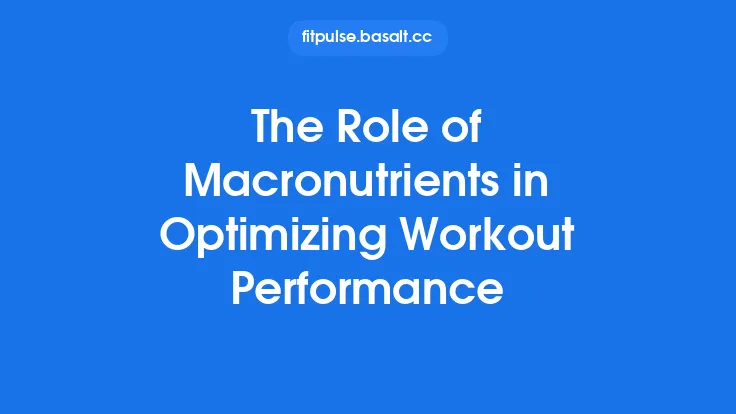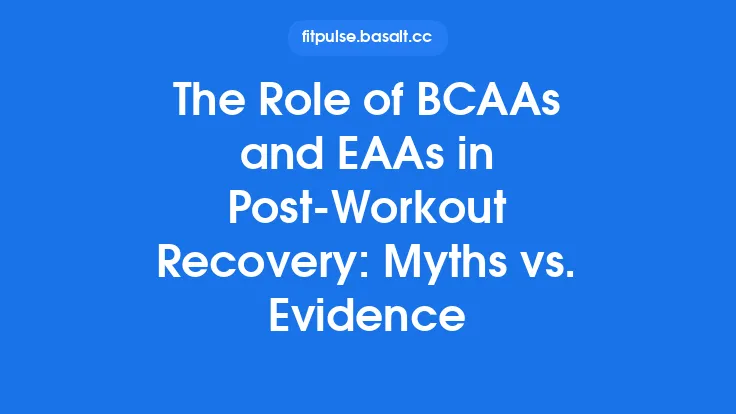Endurance performance hinges on the ability of skeletal muscle to sustain high rates of ATP production over prolonged periods. While many factors contribute to this capacity, the density and functional quality of mitochondria within muscle fibers are arguably the most decisive. Mitochondria are the cellular powerhouses that generate the bulk of aerobic ATP through oxidative phosphorylation, and the process by which new mitochondria are formed—mitochondrial biogenesis—is a central adaptive response to regular endurance training. Understanding how this process is initiated, regulated, and manifested in the muscle tissue provides a mechanistic foundation for designing training programs, nutritional strategies, and even therapeutic interventions aimed at optimizing endurance capacity.
Mitochondrial Structure and Function
Mitochondria are double‑membraned organelles composed of an outer membrane, an inner membrane folded into cristae, and a matrix that houses the tricarboxylic acid (TCA) cycle enzymes and mitochondrial DNA (mtDNA). The inner membrane hosts the electron transport chain (ETC) complexes I–IV and ATP synthase (complex V), which together drive oxidative phosphorylation. The surface area of the inner membrane, amplified by cristae density, directly influences the organelle’s capacity for electron flux and ATP synthesis. In addition to ATP production, mitochondria regulate calcium homeostasis, generate reactive oxygen species (ROS) as signaling molecules, and orchestrate apoptosis—all of which intersect with the adaptive processes of endurance training.
Stimuli Triggering Mitochondrial Biogenesis
Endurance exercise imposes a unique metabolic demand that serves as a potent stimulus for mitochondrial biogenesis. The primary triggers include:
- Increased AMP/ATP Ratio – Prolonged muscle contraction depletes ATP, raising AMP levels and activating AMP‑activated protein kinase (AMPK), a key energy sensor.
- Elevated Cytosolic Calcium – Repetitive contraction elevates intracellular calcium, activating calcium/calmodulin‑dependent protein kinase (CaMK) pathways.
- Transient ROS Production – Moderate increases in mitochondrial ROS act as signaling messengers rather than damaging agents.
- Mechanical Stress and Shear Forces – Repetitive stretch and contraction generate mechanotransductive signals that converge on nuclear transcription factors.
These acute signals converge on a network of transcriptional co‑activators and nuclear receptors that drive the expression of genes required for mitochondrial replication, protein import, and functional assembly.
Key Molecular Pathways
The orchestration of mitochondrial biogenesis involves several interlinked signaling cascades:
- AMPK Pathway – Activated by an increased AMP/ATP ratio, AMPK phosphorylates and activates peroxisome proliferator‑activated receptor gamma co‑activator‑1α (PGC‑1α), the master regulator of mitochondrial biogenesis.
- CaMK Pathway – Calcium influx activates CaMKII and CaMKIV, which also phosphorylate PGC‑1α and stimulate its transcription.
- p38 MAPK Pathway – Mechanical and metabolic stress activates p38 mitogen‑activated protein kinase, which can phosphorylate transcription factors such as ATF2, further enhancing PGC‑1α expression.
- Sirtuin 1 (SIRT1) Pathway – NAD⁺‑dependent deacetylase SIRT1 deacetylates PGC‑1α, increasing its transcriptional activity. Exercise‑induced increases in the NAD⁺/NADH ratio promote SIRT1 activation.
These pathways are not mutually exclusive; rather, they act synergistically to ensure a robust transcriptional response.
Transcriptional Regulators: PGC‑1α and Beyond
PGC‑1α is a transcriptional co‑activator that does not bind DNA directly but interacts with a suite of nuclear receptors and transcription factors, including:
- Nuclear Respiratory Factors (NRF‑1, NRF‑2) – Drive expression of nuclear‑encoded mitochondrial proteins and mitochondrial transcription factor A (TFAM).
- Estrogen‑Related Receptor α (ERRα) – Coordinates expression of genes involved in oxidative metabolism and fatty‑acid oxidation.
- Myocyte Enhancer Factor‑2 (MEF2) – Links contractile activity to mitochondrial gene expression.
Beyond PGC‑1α, other co‑activators such as PGC‑1β and PRC (PGC‑1‑related co‑activator) contribute to mitochondrial biogenesis, particularly under chronic training conditions. Their relative contributions can vary with training volume, intensity, and individual genetic background.
Role of Reactive Oxygen Species and Calcium Signaling
While excessive ROS can damage cellular components, the modest ROS burst generated during moderate‑intensity endurance exercise serves as a redox signal that stabilizes hypoxia‑inducible factor‑1α (HIF‑1α) and activates nuclear factor‑κB (NF‑κB), both of which can indirectly augment PGC‑1α transcription. Calcium signaling, mediated through the sarcoplasmic reticulum, activates CaMK pathways that not only stimulate PGC‑1α but also promote mitochondrial calcium uniporter (MCU) expression, enhancing mitochondrial calcium uptake and thereby improving metabolic flexibility during sustained activity.
Exercise Modalities that Promote Biogenesis
Although the article avoids detailed discussion of specific training protocols, it is useful to note that the frequency, duration, and continuity of aerobic activity are critical determinants of the magnitude of mitochondrial adaptation. Repetitive, submaximal contractions that maintain a steady-state metabolic demand are particularly effective at sustaining the signaling milieu required for chronic mitochondrial expansion. Conversely, brief, high‑intensity bouts may elicit transient spikes in signaling but are less efficient at driving sustained biogenesis unless performed with sufficient volume.
Nutritional and Pharmacological Modulators
Certain nutrients and compounds can amplify the signaling pathways that underlie mitochondrial biogenesis:
- Polyphenols (e.g., resveratrol, quercetin) – Activate SIRT1 and AMPK, enhancing PGC‑1α activity.
- Omega‑3 fatty acids – Modulate membrane fluidity and may up‑regulate PGC‑1α expression.
- Nicotinamide riboside (NR) and nicotinamide mononucleotide (NMN) – Boost NAD⁺ levels, thereby potentiating SIRT1 activity.
- Metformin – Though primarily a glucose‑lowering drug, it activates AMPK and has been shown to stimulate mitochondrial biogenesis in skeletal muscle.
These agents should be considered adjuncts rather than replacements for the primary stimulus of regular endurance activity.
Genetic and Epigenetic Influences
Inter‑individual variability in mitochondrial adaptations is partly rooted in genetic polymorphisms affecting key regulators such as PPARGC1A (the gene encoding PGC‑1α) and AMPK subunits. Epigenetic modifications—DNA methylation, histone acetylation, and microRNA expression—also modulate the transcriptional responsiveness of mitochondrial genes. For instance, endurance training can lead to hypomethylation of the PGC‑1α promoter, facilitating its up‑regulation. Understanding these layers of regulation offers potential for personalized training prescriptions.
Implications for Endurance Performance
An expanded mitochondrial network translates into several performance‑enhancing outcomes:
- Increased Oxidative Capacity – More mitochondria provide a larger surface area for ETC activity, raising maximal aerobic ATP production.
- Improved Substrate Utilization – Enhanced mitochondrial density supports greater fatty‑acid oxidation, sparing limited carbohydrate stores during prolonged effort.
- Accelerated Recovery of Phosphocreatine – Faster oxidative phosphorylation replenishes phosphocreatine stores between bouts of high‑intensity effort, allowing sustained power output.
- Reduced Accumulation of Metabolic By‑products – Efficient electron flow minimizes ROS overproduction and limits oxidative stress, preserving muscle contractile function.
Collectively, these adaptations raise the ceiling for sustainable work rates, delay the onset of fatigue, and improve overall endurance efficiency.
Assessment and Measurement Techniques
Quantifying mitochondrial biogenesis in humans can be approached through several methodologies:
- Muscle Biopsy – Direct measurement of mitochondrial enzyme activities (e.g., citrate synthase, cytochrome c oxidase) and mtDNA copy number.
- Magnetic Resonance Spectroscopy (MRS) – Non‑invasive assessment of phosphocreatine recovery kinetics, an indirect index of oxidative capacity.
- Near‑Infrared Spectroscopy (NIRS) – Estimates muscle oxygen consumption and can infer mitochondrial function during exercise.
- Molecular Imaging – PET tracers targeting mitochondrial metabolism provide whole‑body insights but are less common in routine research.
These tools enable researchers and practitioners to track the efficacy of training interventions and to tailor programs based on individual adaptive responses.
Practical Recommendations for Athletes and Coaches
- Prioritize Consistent Aerobic Volume – Regular sessions that maintain a moderate intensity for extended periods are the most reliable drivers of mitochondrial expansion.
- Incorporate Periodic Low‑Intensity “Mito‑Boost” Sessions – Sessions performed at 50–65 % of maximal oxygen uptake can sustain signaling without excessive fatigue.
- Leverage Nutritional Timing – Consuming polyphenol‑rich foods or NAD⁺ precursors in proximity to training may augment signaling pathways.
- Monitor Recovery – While the focus is on mitochondrial growth, adequate rest ensures that signaling cascades are not blunted by chronic stress.
- Consider Individual Genetics – Where feasible, genetic testing for PPARGC1A variants can inform the expected magnitude of adaptation and guide program intensity.
Future Directions and Research Gaps
Despite substantial progress, several areas warrant further investigation:
- Mitochondrial Quality vs. Quantity – Understanding how training influences mitochondrial dynamics (fusion, fission, mitophagy) alongside biogenesis.
- Sex‑Specific Responses – Hormonal milieu may modulate signaling pathways differently in males and females.
- Interaction with the Microbiome – Emerging evidence suggests gut‑derived metabolites can affect systemic NAD⁺ levels and, consequently, mitochondrial biogenesis.
- Long‑Term Sustainability – Determining the durability of mitochondrial adaptations after detraining and the optimal “maintenance” stimulus.
Addressing these questions will refine our ability to harness mitochondrial biogenesis for maximal endurance performance.
Conclusion
Mitochondrial biogenesis stands at the core of the physiological adaptations that enable athletes to excel in endurance disciplines. Through a cascade of energy‑sensing, calcium‑mediated, and redox‑dependent signals, regular aerobic activity activates a network of transcriptional regulators—chiefly PGC‑1α—that orchestrate the synthesis of new mitochondria and the remodeling of existing ones. The resultant increase in oxidative capacity, substrate flexibility, and metabolic efficiency directly translates into superior endurance performance. By integrating knowledge of the underlying molecular mechanisms with practical training, nutritional, and individualized strategies, coaches and athletes can deliberately shape the mitochondrial landscape of skeletal muscle, unlocking higher levels of sustained athletic output.





